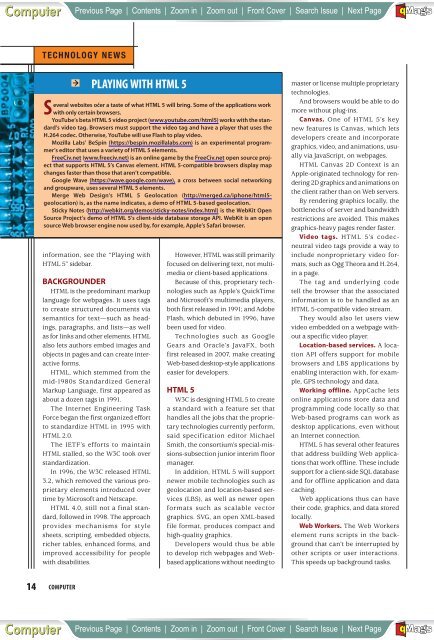computing lives - FTP Directory Listing
computing lives - FTP Directory Listing
computing lives - FTP Directory Listing
Create successful ePaper yourself
Turn your PDF publications into a flip-book with our unique Google optimized e-Paper software.
A<br />
Computer Previous Page | Contents | Zoom in | Zoom out | Front Cover | Search Issue | Next Page M S BE<br />
aG<br />
F<br />
14<br />
TECHNOLOGY NEWS<br />
PLAYING WITH HTML 5<br />
Several websites očer a taste of what HTML 5 will bring. Some of the applications work<br />
with only certain browsers.<br />
YouTube’s beta HTML 5 video project (www.youtube.com/html5) works with the standard’s<br />
video tag. Browsers must support the video tag and have a player that uses the<br />
H.264 codec. Otherwise, YouTube will use Flash to play video.<br />
Mozilla Labs’ BeSpin (https://bespin.mozillalabs.com) is an experimental programmer’s<br />
editor that uses a variety of HTML 5 elements.<br />
FreeCiv.net (www.freeciv.net) is an online game by the FreeCiv.net open source project<br />
that supports HTML 5’s Canvas element. HTML 5-compatible browsers display map<br />
changes faster than those that aren’t compatible.<br />
Google Wave (https://wave.google.com/wave), a cross between social networking<br />
and groupware, uses several HTML 5 elements.<br />
Merge Web Design’s HTML 5 Geolocation (http://merged.ca/iphone/html5geolocation)<br />
is, as the name indicates, a demo of HTML 5-based geolocation.<br />
Sticky Notes (http://webkit.org/demos/sticky-notes/index.html) is the WebKit Open<br />
Source Project’s demo of HTML 5’s client-side database storage API. WebKit is an open<br />
source Web browser engine now used by, for example, Apple’s Safari browser.<br />
information, see the “Playing with<br />
HTML 5” sidebar.<br />
BACKGROUNDER<br />
HTML is the predominant markup<br />
language for webpages. It uses tags<br />
to create structured documents via<br />
semantics for text—such as headings,<br />
paragraphs, and lists—as well<br />
as for links and other elements. HTML<br />
also lets authors embed images and<br />
objects in pages and can create interactive<br />
forms.<br />
HTML, which stemmed from the<br />
mid-1980s Standardized General<br />
Markup Language, first appeared as<br />
about a dozen tags in 1991.<br />
The Internet Engineering Task<br />
Force began the first organized effort<br />
to standardize HTML in 1995 with<br />
HTML 2.0.<br />
The IETF’s efforts to maintain<br />
HTML stalled, so the W3C took over<br />
standardization.<br />
In 1996, the W3C released HTML<br />
3.2, which removed the various proprietary<br />
elements introduced over<br />
time by Microsoft and Netscape.<br />
HTML 4.0, still not a final standard,<br />
followed in 1998. The approach<br />
provides mechanisms for style<br />
sheets, scripting, embedded objects,<br />
richer tables, enhanced forms, and<br />
improved accessibility for people<br />
with disabilities.<br />
COMPUTER<br />
However, HTML was still primarily<br />
focused on delivering text, not multimedia<br />
or client-based applications.<br />
Because of this, proprietary technologies<br />
such as Apple’s QuickTime<br />
and Microsoft’s multimedia players,<br />
both first released in 1991; and Adobe<br />
Flash, which debuted in 1996, have<br />
been used for video.<br />
Technologies such as Google<br />
Gears and Oracle’s JavaFX, both<br />
first released in 2007, make creating<br />
Web-based desktop-style applications<br />
easier for developers.<br />
HTML 5<br />
W3C is designing HTML 5 to create<br />
a standard with a feature set that<br />
handles all the jobs that the proprietary<br />
technologies currently perform,<br />
said specification editor Michael<br />
Smith, the consortium’s special-missions-subsection<br />
junior interim floor<br />
manager.<br />
In addition, HTML 5 will support<br />
newer mobile technologies such as<br />
geolocation and location-based services<br />
(LBS), as well as newer open<br />
formats such as scalable vector<br />
graphics. SVG, an open XML-based<br />
file format, produces compact and<br />
high-quality graphics.<br />
Developers would thus be able<br />
to develop rich webpages and Webbased<br />
applications without needing to<br />
master or license multiple proprietary<br />
technologies.<br />
And browsers would be able to do<br />
more without plug-ins.<br />
Canvas. One of HTML 5’s key<br />
new features is Canvas, which lets<br />
developers create and incorporate<br />
graphics, video, and animations, usually<br />
via JavaScript, on webpages.<br />
HTML Canvas 2D Context is an<br />
Apple-originated technology for rendering<br />
2D graphics and animations on<br />
the client rather than on Web servers.<br />
By rendering graphics locally, the<br />
bottlenecks of server and bandwidth<br />
restrictions are avoided. This makes<br />
graphics-heavy pages render faster.<br />
Video tags. HTML 5’s codecneutral<br />
video tags provide a way to<br />
include nonproprietary video formats,<br />
such as Ogg Theora and H.264,<br />
in a page.<br />
The tag and underlying code<br />
tell the browser that the associated<br />
information is to be handled as an<br />
HTML 5-compatible video stream.<br />
They would also let users view<br />
video embedded on a webpage without<br />
a specific video player.<br />
Location-based services. A location<br />
API offers support for mobile<br />
browsers and LBS applications by<br />
enabling interaction with, for example,<br />
GPS technology and data.<br />
Working offline. AppCache lets<br />
online applications store data and<br />
programming code locally so that<br />
Web-based programs can work as<br />
desktop applications, even without<br />
an Internet connection.<br />
HTML 5 has several other features<br />
that address building Web applications<br />
that work offline. These include<br />
support for a client-side SQL database<br />
and for offline application and data<br />
caching.<br />
Web applications thus can have<br />
their code, graphics, and data stored<br />
locally.<br />
Web Workers. The Web Workers<br />
element runs scripts in the background<br />
that can’t be interrupted by<br />
other scripts or user interactions.<br />
This speeds up background tasks.<br />
A<br />
Computer Previous Page | Contents | Zoom in | Zoom out | Front Cover | Search Issue | Next Page M S BE<br />
aG<br />
F

















